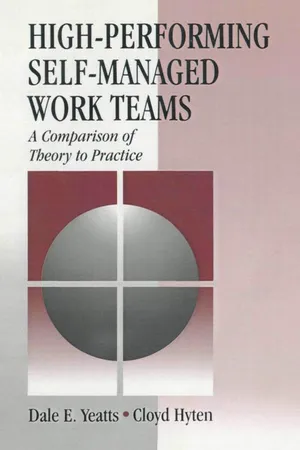Business
Performance Evaluation
Performance evaluation is the process of assessing an employee's job performance and productivity. It involves setting clear expectations, providing feedback, and measuring progress towards goals. This helps in identifying strengths and areas for improvement, and can inform decisions related to promotions, bonuses, and training opportunities.
Written by Perlego with AI-assistance
Related key terms
1 of 5
11 Key excerpts on "Performance Evaluation"
- eBook - PDF
High-Performing Self-Managed Work Teams
A Comparison of Theory to Practice
- Dale E. Yeatts, Cloyd Hyten(Authors)
- 1997(Publication Date)
- SAGE Publications, Inc(Publisher)
On the other hand, performance assessment is a term often used to refer to collections of various measures in domains such as quality, efficiency, or productivity that are taken more regularly for an SMWT or for a larger administrative unit such as an entire plant. We will subsume both of these types of measurement under the generic heading of performance measurement. Both kinds of measurement, in some form, are currently used by organizations to assess team and individual progress. The Traditional Performance Appraisal Performance appraisal systems evolved when traditional hierarchical management structures were dominant. This meant that, typically, a super-visor or manager evaluated subordinates on an individual basis. Performance appraisals can serve many purposes. According to Scholtes (1987), tradi-tional performance appraisals have been used to serve too many purposes. For example, they could be used to identify candidates for promotion and as a basis for salary increases or bonus pay. They could also provide feedback to the employees regarding their performance in the review period and give them some direction. If skill deficits were identified, areas for training could be suggested. The performance appraisal also provided the opportunity for recognition for outstanding performance. It also enabled corporations to meet various Equal Employment Opportunity Commission (EEOC) guide-lines regarding the need for documentation in promotion and termination decisions. In some limited sense, although perhaps the only sense in some organizations, the appraisal was a channel for management-employee com-munication. Performance appraisals typically include some standard or goal, a perfor-mance period during which a manager presumably monitors employee per-formance, and a performance review and rating of the employee on various dimensions thought to be critical to the standard or goal. - eBook - ePub
- Elearn(Author)
- 2009(Publication Date)
- Routledge(Publisher)
Evaluating performance
Organisations are continually asking people to perform better. This theme examines ways to set and agree individual goals and provide objective feedback on performance. It also explores how to review team performance in a way that leads to performance improvements.Is development working? There is more pressure today than ever before to produce results from staff development programmes and initiatives. If development is not shown to add value, it may be difficult to justify the expense. This theme looks at how monitoring, measurement and evaluation of development can be used as a management tool to determine what is and is not working as well as anticipated.In this theme you will:Explore the processes used to review individual and team performancePlan to meet the performance review needs of individualsIdentify ways of evaluating developmentConsider ways of increasing the effectiveness of development.Performance reviews
A performance review or appraisal is where you provide feedback to your team and individual members of the team on their performance and set goals for the future. You should regard this as one of your most important responsibilities. The purpose of a performance review is to:improve the individual's – and therefore, an organization's performance. To do so, the appraisal has to be responsive to individual needs and be available to individuals throughout the organization. - eBook - PDF
Effective Management of Student Employment
Organizing for Student Employment in Academic Libraries
- David A. Baldwin, Frances C. Wilkinson, Daniel C. Barkley(Authors)
- 2000(Publication Date)
- Libraries Unlimited(Publisher)
Performance appraisals do not always result in "praises or raises," but they can and should be constructive and positive experiences for you and your student employees. JOB EVALUATION VERSUS PERFORMANCE APPRAISAL Job evaluation is an evaluation of the duties and responsibilities of a specific job or group of jobs. Performance appraisal is a measure- ment of how well an employee is doing that job. Performance appraisal or Performance Evaluation is sometimes called a merit rating. Essentially, job evaluation is a technique for evaluating a job; the other evaluates an individual. Performance appraisals have two basic purposes: employee evaluation and employee development. For most companies, evaluation for administrative purposes has been the most common use of the process. Appraisals of employee performance provide the basis for administra- tive decisions about promotions, demotions, terminations, transfers, and rewards. The development purpose has generally been secondary. Evaluations used to improve performance on the job is becoming more common in industry. The following chart (table 10.1) shows how com- panies used Performance Evaluations in 1984 and indicates a shift to a more balanced approach. 1 Job Evaluation Versus Performance Appraisal I 235 Table 10.1. Purpose of the Performance Appraisal Process PURPOSE OF APPRAISAL PERCENTAGE OF RESPONDENTS compensation 85.6 counseling 65.1 training and development 64.3 promotion 45.3 manpower planning 43.1 retention/discharge 30.3 validation of selection technique 17.2 Academic institutions view performance appraisal from a devel- opment viewpoint. There are three basic reasons for performance appraisal for library student employees: 1. To encourage good performance and to correct or discourage substandard performance. Good performers expect a reward, even if it is only praise. - eBook - PDF
- Bob Nelson, Peter Economy, Kerry Sommerville, Laura Town(Authors)
- 2012(Publication Date)
- Wiley(Publisher)
There are positive elements of Performance Evaluations: 9.4 EVALUATING PERFORMANCE 203 ▲ A chance to summarize past performance and establish new perfor- mance goals: All employees want to know whether they’re doing a good job. Formal Performance Evaluations force managers to communicate performance results—both good and bad—to their employees and to set new goals. In many organizations, the annual Performance Evaluation is the only occasion when supervisors and managers speak to their employ- ees about performance expectations and the results of employee efforts for the preceding evaluation period. ▲ An opportunity for clarification and communication: You need to con- stantly compare expectations. In fact, try this exercise with your manager. List your ten most important activities. Then ask your manager to list what he or she considers to be your ten most important activities. Chances are, your lists are quite different. On average, business people who do this exercise find that their lists overlap only 40 percent at best. Performance Evaluations help the employer and employee compare notes and make sure that assignments and priorities are in order. ▲ A forum for learning goals and career development: In many organi- zations, career development takes place as a part of the formal perfor- mance evaluation process. Managers and employees are busy and often have difficulty setting aside the time to sit down and chart out the steps that they must take to progress in an organization or career. Although career development discussions should generally take place in a forum separate from the Performance Evaluation process, combining the activi- ties does afford the opportunity to kill both birds with the same stone, or something like that. ▲ A formal documentation to promote advancement or dismissal: Most employees get plenty of informal performance feedback—at least of the negative kind. Most informal feedback is verbal and, as such, undocumented. - Minnaar F(Author)
- 2012(Publication Date)
- Van Schaik Publishers(Publisher)
What monitoring and evaluation have in com-mon is that they are geared towards learning from what is being done and how it is being done by focusing on efficiency, effectiveness and impact. In terms of evaluation , the guide (Free State Provincial Government 2001) draws a distinc-tion between review and evaluation . Review is regarded as the management instrument where-by performance must be measured at regular intervals (mostly quarterly). The performance review is a formal overview of progress made in reaching objectives and targets. Evaluation is done at the end of the performance and devel-opment management cycle and is based on information gathered during the monitoring and the review phases of the process. For the purposes of this chapter, review and evaluation will be regarded as two parts of a single process aimed at evaluating actual perform-ance progress against planned performance. Performance planning is done for 1. the institution or organisation (as reflected in the institutional performance plans) and, through the performance plans, also for its subcomponents 2. the individuals in the organisation or insti-tution, through the translation of institu-tional performance targets into the per-formance plans of individual employees. An institutional performance monitoring and evaluation system will therefore also make pro-vision for assessing the executing institution as a whole and the individual. 9.3 Scorecards Scorecards are, as the name suggests, cards that reflect scores . The scores are the results of the Performance Evaluations conducted in the institution, both on an institutional and an indi-vidual level. There are different scorecard models, but the best known of these is the so-called balanced scorecard , developed and presented by Robert Kaplan and David Norton (see Figure 9.1).- eBook - PDF
- David A. DeCenzo, Stephen P. Robbins(Authors)
- 2014(Publication Date)
- Wiley(Publisher)
This reflects the historic belief that individuals are the core building block on which organizations are built. 51 But as we’ve witnessed, more con- temporary organizations are restructuring themselves around teams. How should organizations using teams evaluate perform- ance? Four suggestions have been offered for designing an effec- tive system that supports and improves team performance. 52 1. Tie team results to organization goals. It’s important to find measures that apply to important goals the team should accomplish. 2. Begin with the team’s customers and its work process to satisfy customers’ needs. The final product the customer receives can be evaluated in terms of the customer’s require- ments. Transactions between teams can be evaluated based on delivery and quality. And the process steps can be evalu- ated based on waste and cycle time. 3. Measure both team and individual performance. Define the roles of each team member in terms of accomplish- ments that support the team’s work process. Then assess each member’s contributions and the team’s overall performance. 4. Train the team to create its own measures. Having the team define its objectives and those of each member ensures everyone understands their role on the team and helps the team develop into a more cohesive unit. Things to think about: What concerns would you have about being part of a team eval- uation? Should individual performance be measured too? Team Performance Appraisals TIPS FOR SUCCESS upward appraisal Employees provide frank and constructive feedback to their supervisors. 360-degree appraisals Performance Evaluations in which supervisors, peers, employees, cus- tomers, and the like, evaluate the individual. The Performance Appraisal Meeting 265 artificially inflating or penalizing coworkers to help their own ratings. Anonymity of raters and rater training is necessary. Rate Selectively Appraisers should rate only in those areas in which they have job knowledge. - eBook - PDF
Governance and Social Responsibility
International Perspectives
- Güler Aras, David Crowther(Authors)
- 2017(Publication Date)
- Red Globe Press(Publisher)
11 Performance Evaluation and Performance Reporting Learning objectives After studying this chapter you should be able to: • Define the various aspects of performance. • Discuss competing requirements of stakeholders. • Outline the design of the balanced scorecard and discuss alternatives. • Discuss the purpose of the reporting of performance. • Distinguish between financial performance and social performance. • Explain what is meant by triple bottom line reporting. I think that Capitalism, wisely managed, can probably be made more efficient for attaining economic ends than any alternative system yet in sight. But that in itself is in many ways extremely objectionable. Our problem is to work out a social organization which shall be as efficient as possible without offending our notions of a satisfactory way of life. (John Maynard Keynes, 1926) Introduction For all organisations the question of the management of the organisation depends upon the ability to measure performance and then evaluate and report upon that performance. When we are considering CSR this is equally true, although it becomes more difficult to measure and evaluate that performance. In this chapter, therefore, we will consider some of the issues involved as well as some of the aspects of performance. 211 212 GOVERNANCE AND SOCIAL RESPONSIBILITY What is performance? It should be clear that the determination of good performance is dependent upon the perspective from which that performance is being considered and that what one stakeholder grouping might consider to be good performance may very well be considered by another grouping to be poor performance (Child, 1984). The evaluation of performance for a business therefore depends not just upon the identification of adequate means for measuring that performance but also upon the determination of what good performance actually consists of. - James H. Dulebohn, Dianna L. Stone(Authors)
- 2014(Publication Date)
- Information Age Publishing(Publisher)
Schaubroeck, Shaw, Duffy, and Mitra (2008) note that this is probably the most popular method of implementing pay plans designed to create financial incentives to perform well. Performance appraisals are often an important component of employee training and development. Systems that help workers identify their strengths and weaknesses have the potential to also help guide their development. That is, they can give you and your organization specific ideas about areas where development is needed. They allow individuals and organizations to make informed deci- sions about which training and development programs and resources are most necessary. In the majority of organizations, performance appraisal systems are used both as a basis for (or a critically important input into) high-stakes deci- sions and as a basis for the sort of performance feedback that might lead to meaningful improvements in job performance. As Meyer et al. (1965) noted more than 50 years ago, performance appraisal often involves split roles, in 28 J. N. CLEVELAND and K. R. MURPHY which the supervisor is both a judge who can influence rewards and sanc- tions (e.g., promotions, raises) and a helper who can aid employees in devel- oping the knowledge and skills needed to perform well. Unfortunately, the use of performance appraisals for both between and within person distinc- tions (i.e., using overall performance ratings to decide raises and individual strengths and weaknesses to target training) rarely works well, because of the inherent conflict in these two roles (Murphy & Cleveland, 1995). Are There Useful Alternatives to Traditional Performance Ratings? Recent publications have suggested two different approaches to replac- ing traditional performance appraisals. The first comes from research on performance management, where it has been suggested that annual per- formance appraisals might be replaced by more frequent, informal, and immediate feedback from supervisors or managers (Aguinis, 2013).- eBook - PDF
- Abdul Ghani, Ooi Kee Beng(Authors)
- 2005(Publication Date)
- ISEAS Publishing(Publisher)
PERFORMANCE MEASUREMENT AND MANAGEMENT 111 16 Performance Measurement and Management Christopher Mills INTRODUCTION Academics and HR practitioners have long been absorbed with constructing the perfect performance measurement system. In the hidden depths of many leaders’ minds lies the “Shangri-la” of the definitive approach to performance management. It has been re-awoken in the last decade by the resurgence of strategy-driven methodology, the process improvement culture of re-engineering, value-chain management and six-sigma, to the extent that measurement is swiftly acquiring a Nirvana-like status and becoming an additional discipline in the guise of economic value addedness (EVA), balanced scorecard, activity-based costing (ABC) and enterprise performance solutions. The present interest in performance is therefore justified when we see that “measurement managed” companies outperform others (Schiemann & Lingle 1999). Performance measurement and appraisal is probably the most researched area within human resources management. Agreeing on an effective method, however, has been like searching for the lost city of Atlantis i.e., hard to find. The pavements of literature are littered with discarded approaches to finding the elixir to managing employee performance. As a result, the scroll of managing performance in the twentieth century unfolded, vacillating between setting specific directions through objectives and measuring what has been accomplished or by making a judgement on how staff has performed using traits or performance factors. However, in the New Economy this means Out with boring achievement terminology such as MBO (Management by Objectives) and goals and In with hyped up New Economy KPIs (key performance indicators) and metrics. This also means a kick in the pants for terms that designate how - eBook - PDF
Accounting
Business Reporting for Decision Making
- Jacqueline Birt, Keryn Chalmers, Suzanne Maloney, Albie Brooks, David Bond, Judy Oliver(Authors)
- 2022(Publication Date)
- Wiley(Publisher)
The people working within a company perform multiple tasks, individually and in teams, to accomplish the organisation’s goals. Performance measurement at the individual level should highlight to the employees what tasks are important. For example, a sales assistant may be required to assist customers and make sales. Including both tasks in a performance measurement system helps managers communicate this to the employee. The performance system may include a customer satisfaction measure and a dollar sales measure. If only the sales dollars were measured, then the sales assistant might focus on making as many sales as possible with little regard to customer service and needs — and the customer might never return. Such short-term gains would not be good for the entity in the longer term. CHAPTER 14 Performance measurement 537 FIGURE 14.5 JB Hi-Fi Ltd — executive compensation Short-term employee benefits Post-employment benefits Share based payments 2021 Salary, fees & allowances $ Bonus $ VRP cash $ Total short-term employee benefits $ Superannuation $ Options $ VRP $ Total share based payments $ Total $ Non-executive directors S. Goddard 303 306 — — 303 306 21 694 — — — 325 000 B. Laughton 164 384 — — 164 384 15 616 — — — 180 000 M. Powell 149 772 — — 149 772 14 228 — — — 164 000 G. Roberts 62 785 — — 62 785 5 965 — — — 68 750 R. Uechtritz 122 374 — — 122 374 11 626 — — — 134 000 M. Wilson 137 081 — — 137 081 13 023 — — — 150 104 939 702 — — 939 702 82 152 — — — 1 021 854 Executives R. Murray 1 475 000 — 851 175 2 326 175 24 519 292 459 1 615 879 1 908 338 4 259 032 C. Trainor 1 025 600 — 439 335 1 464 935 24 519 143 238 1 061 417 1 204 655 2 694 109 T. Smart 1 064 095 — 442 723 1 506 818 25 000 264 275 479 616 743 891 2 275 709 N. - eBook - PDF
Industrial/Organizational Psychology
An Applied Approach
- Michael Aamodt(Author)
- 2015(Publication Date)
- Cengage Learning EMEA(Publisher)
Cengage Learning reserves the right to remove additional content at any time if subsequent rights restrictions require it. Step 1: Determine the Reason for Evaluating Employee Performance The first step in the performance appraisal process is to determine the reasons your organization wants to evaluate employee performance. That is, does the organization want to use the results to improve performance? Give raises on the basis of perfor-mance? This determination is important because the various performance appraisal techniques are appropriate for some purposes but not for others. For example, a per-formance appraisal method—the forced-choice rating scale (see Appendix at the end of the chapter)—is excellent for determining compensation but terrible for training purposes. Likewise, the use of 360-degree feedback is an excellent source for improv-ing employee performance but is not appropriate for determining salary increases. Surprisingly, most organizations do not have specific goals for their performance appraisal systems. As a result, it comes as no surprise that several national surveys found that the vast majority of performance appraisal systems are not successful (Coens & Jenkins, 2002). Though there are many uses and goals for performance appraisal, the most common include providing employee feedback and training, determining salary increases, making promotion decisions, making termination decisions, and conducting personnel research. Providing Employee Training and Feedback By far, the most important use of Performance Evaluation is to improve employee per-formance by providing feedback about what employees are doing right and wrong. Even though employee training should be an ongoing process (see Chapter 8), the semiannual performance appraisal review is an excellent time to meet with employ-ees to discuss their strengths and weaknesses. But more important, it is the time to determine how weaknesses can be corrected.
Index pages curate the most relevant extracts from our library of academic textbooks. They’ve been created using an in-house natural language model (NLM), each adding context and meaning to key research topics.










